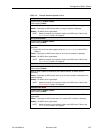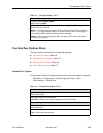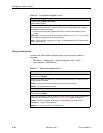
Configuration Option Tables
A-12
7610-A2-GB20-10November 1997
Table A-4. Terminal Port Options (2 of 3)
Parity
Possible Settings: None, Even, Odd
Default Setting: None
Specifies Parity for the Terminal port.
None – Provides no parity.
Even – Parity is even.
Odd – Parity is odd.
Stop Bits
Possible Settings: 1, 1.5, 2
Default Setting: 1
Provides the number of stop bits for the Terminal port.
1, 1.5, or 2 – Selects the number of stop bits.
Monitor DTR
Possible Settings: Enable, Disable
Default Setting: Enable
Specifies monitoring of the Data Terminal Ready (DTR) control lead.
Enable – Standard operation of the DTR control lead.
Disable – DTR is ignored. Some external device connections may require this setting.
Login Required
Possible Settings: Enable, Disable
Default Setting: Disable
Used to secure access to the ATI through the Terminal port. Login IDs are created with
a password and access level.
Enable – Security is enabled. When ATI access is attempted through the Terminal port,
a screen appears that requires a Login ID and password.
Disable – Main menu appears with no Login required.
NOTE: Refer to the
Creating a Login
section of Chapter 4.
Port Access Level
Possible Settings: Level 1, Level 2, Level 3
Default Setting: Level 1
The Terminal port access level is interrelated with the access level of the Login ID.
Level 1 – This is the highest access level. If Login Required is disabled, the Terminal
port access is level 1. If Login Required is enabled, the effective level is the Login ID
access level.
Level 2 – This access level overrides a Login ID with an access level 1. If a Login ID
has an access level of 3, the effective access level is 3.
Level 3 – This access level becomes the effective access level and overrides a Login
ID with an access level of 1 or 2.
NOTE: Refer to the
ATI Access
section of Chapter 4 for access level details.


















